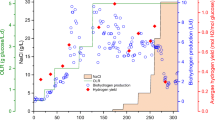Summary
A thermophilic anaerobic sludge digestor was adapted to lactate metabolism. The adapted sludge showed an improved capacity for lactate degradation when tested by a batch activity test, compared to the performance of unadapted sludge. Acetate was the major intermediate produced during the degradation. When adapted sludge was used as the inoculum for a lactate-fed, upflow anaerobic sludge blanket (UASB) reactor, the chemical oxygen demand reduction rate was higher than with unadapted sludge. After 39 days, however, the difference vanished due to an extensive wash-out of sludge from the reactor inoculated with adapted sludge.
Similar content being viewed by others
References
Andreesen JR, Gottschalk G, Schlegel HG (1970) Clostridium formicoaceticum nov. spec. Isolation, description and distinction from C. acetisum and C. thermoaceticum. Arch Microbiol 72:154–174.
Angelidaki I, Petersen SP, Ahring BK (1990) Effects of lipids on thermophilic anaerobic digestion and reduction of lipid inhibition upon addition of bentonite. Appl Microbiol Biotechnol 33:469–472.
Balch WE, Schoberth S, Tanner RS, Wolfe RS (1977) Acetobacterium, a new genus of hydrogen-oxidizing, carbon dioxide-reducing bacteria. Int J Syst Bacteriol 27:355–361.
Brune G, Schoberth SM, Sahm H (1982) Anaerobic treatment of an industrial wastewater containing acetic acid, furfural and sulphite. Process Biochem 17:20–35.
Bryant MP, Campbell LL, Reddy CA, Crabill MR (1977) Growth of Desulfovibrio in lactate or ethanol media low in sulfate in association with H2-utilizing methanogenic bacteria. Appl Environ Microbiol 33:1162–1169.
Chen M, Wolin MJ (1977) Influence of CH4 production by Methanobacterium r ruminantium on the fermentation of glucose and lactate by Selenomonas ruminantium. Appl Environ Microbiol 34:756–759.
Christensen D, Blackburn TH (1982) Turnover of 14C-labelled acetate in marine sediments. Mar Biol 71:113–119.
Ferguson TJ, Mah RA (1983) Effect of H2-CO2 on methanogenesis from acetate or methanol in Methanosarcina spp. Appl Environ Microbiol 46:348–355.
Hendriksen HV, Ahring BK (1988) Anaerobic degradation of lactic acid containing waste water with different concentrations of ammonia. In: Tilche A, Rozzi A (eds) Poster papers. Fifth International Symposium on Anaerobic Digestion, Bologna, Italy, 22–26 May 1988. Monduzzi Editore, Bologna, pp 125–128.
Lee MJ, Zinder SH (1988) Hydrogen partial pressures in a thermophilic acetate-oxidizing methanogenic coculture. Appl Environ Microbiol 54:1457–1461.
Lindgren SE, Axelsson LT, McFeeters RF (1990) Anaerobic l-lactate degradation by Lactobacillus plantarum. FEMS Microbiol Lett 66:209–214.
Mackie RI, Bryant MP (1981) Metabolic activity of fatty acid-oxidizing bacteria and the contribution of acetate, propionate, butyrate, and CO2 to methanogenesis in cattle waste at 40 and 60°C. Appl Environ Microbiol 41:1363–1373.
Mah RA, Xun L-Y, Boone DR, Ahring B, Smith PH, Wilkie A (1990) Methanogenesis from propionate in sludge and enrichment systems. In: Bélaich J-P, Broschi M, Garcia J-L (eds) Microbiology and Biochemistry of Strict Anaerobes involved in Interspecies Hydrogen Transfer, FEMS Symposium No. 54, Plenum, New York.
McInerney MJ, Bryant MP (1980) Syntrophic associations of H2-utilizing methanogenic bacteria and H2-producing alcohol and fatty acid-degrading bacteria in anaerobic degradation of organic matter. In: Gottschalk G (eds) Anaerobes and anaerobic infections. Fischer, Stuttgart, pp 117–126.
Nielsen J, Nikolajsen K (1989) Structured models for microbial systems. Ph. D. thesis, Department of Biotechnology, Technical University of Denmark, Lyngby.
Pankhania IP, Gow LA, Hamilton WA (1986) The effect of hydrogen on the growth of Desulfovibrio vulgaris (Hildenborough) on lactate. J Gen Microbiol 132:3349–3356.
Rinzema A, Lier J van, Lettinga G (1988) Sodium inhibition of acetoclastic methanogens in granular sludge from a UASB reactor. Enzyme Microb Technol 10:24–32.
Stanier RY, Ingraham JL, Wheelis ML, Painter PR (1986) General microbiology, 5th edn. Macmillan, Houndmills.
Taras MJ, Greenberg AE, Hoak RD, Rand MC (eds) (1971) Standard methods for the examination of water and waste water. American Public Health Association, Washington, D.C.
Thauer RK, Jungermann K, Decker K (1977) Energy conservation in chemotrophic anaerobic bacteria. Bacteriol Rev 41:100–180.
Widdel F, Kohring G-W, Mayer F (1983) Studies on dissimilatory sulfate-reducing bacteria that decompose fatty acids III. Characterization of the filamentous gliding Desulfonema limicola gen. nov. sp.,nov., and Desulfonema magnum sp. nov. Arch Microbiol 134:286–294.
Winther-Nielsen M, Ahring BK (1988) Experiences from start-up of a thermophilic UASB-reactor on lactate as sole carbon and energy source. In: Tilche A, Rozzi A (eds) Poster papers. Fifth International Symposium on Anaerobic Digestion, Bologna, Italy, 22–26 May 1988. Monduzzi Editore, Bologna, pp 351–353.
Wolin EA, Wolin MJ, Wolfe RS (1963) Formation of methane by bacterial extracts. J Biol Chem 238:2882–2886.
Zinder SH, Koch M (1984) Non-aceticlastic methanogenesis from acetate: acetate oxidation by a thermophilic syntrophic coculture. Arch Microbiol 138:263–272.
Zinder SH, Mah RA (1979) Isolation and characterization of a thermophilic strain of Methanosarcina unable to use H2-CO2 for methanogenesis. Appl Environ Microbiol 38:996–1008.
Author information
Authors and Affiliations
Additional information
Offprint requests to: B. K. Ahring
Rights and permissions
About this article
Cite this article
Sørensen, A.H., Winther-Nielsen, M. & Ahring, B.K. Kinetics of lactate, acetate and propionate in unadapted and lactate-adapted thermophilic, anaerobic sewage sludge: the influence of sludge adaptation for start-up of thermophilic UASB-reactors. Appl Microbiol Biotechnol 34, 823–827 (1991). https://doi.org/10.1007/BF00169358
Received:
Accepted:
Issue Date:
DOI: https://doi.org/10.1007/BF00169358




